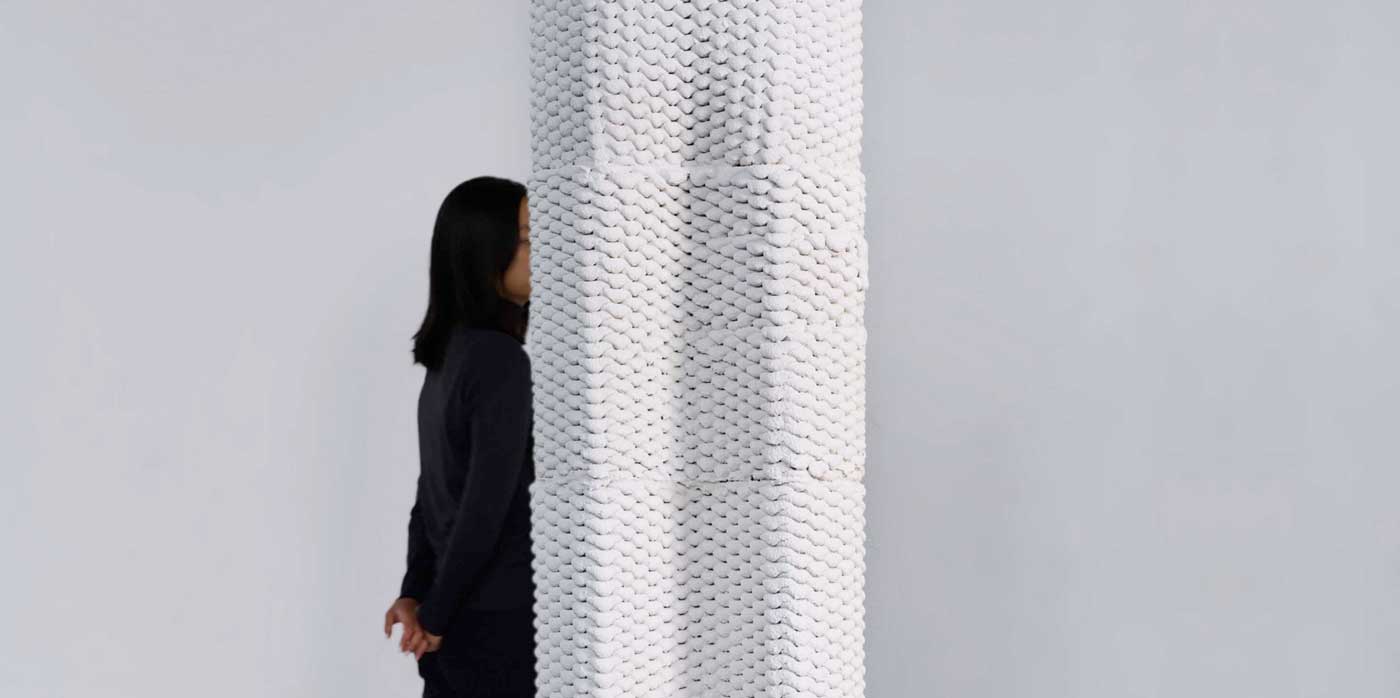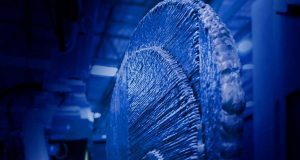In collaboration with FenX AG, ETH Zurich is developing 3D printing of cement-free mineral foams made from recycled waste for monolithic, lightweight and insulated wall structures.
Patrick Bedarf, a member of the Digital Construction Technologies group led by Professor Benjamin Dillenburger and a recent PhD graduate, is standing in front of one of these structures. In his doctoral thesis, he investigated the production of lightweight, insulating building elements in complex shapes in order to save material.
Bedarf used a sustainable insulating material produced by the ETH spin-off FenX from recycled industrial waste. “The mineral foam we use is an innovative construction material that contributes to a more climate-friendly industry,” Bedarf explains. The foam consists mainly of fly ash, a waste product from industrial blast furnaces.
“This material has therefore already gone through the first material cycle, and can simply be recycled after use,” Bedarf explains and crumbles between his fingers the random component he has just pulled out of the wooden crate. “The material can now be reused as a novel foam.”
The research was published in the journal “3D Printing and Additive Manufacturing”. It describes the production of insulating wall elements using 3D printing as a sustainable process that reduces material waste and CO2 emissions.
“The formwork needed for pouring material is no longer required. Formwork is very time-consuming and can only be partially reused afterwards,” Bedarf says. “Without automation, traditional construction methods that save on materials are very time-consuming and expensive, especially due to labor costs.”
“Take this piece, for example, which looks like a pizza,” he says, and points to a flat disk. “We printed several different types of these small “pizzas” to begin with, and then moved on to bigger pieces to see whether foam produced by 3D printing is also suitable for large-scale applications.
An entire room in the laboratory is used as a 3D printer. Robotic arms equipped with print heads apply the material layer by layer.
The robots can navigate precisely to every predefined point in the room,” Bedarf explains. “We program the relevant path and specify where they travel and how quickly, as well as how much material should flow from the printer head, and at what time and place.”
In initial tests, Bedarf used concrete to reinforce the individual components. He later succeeded in producing robust components using foam alone, as shown in the prototype of the Airlement project: a monolithic corner column made of four 3D-printed segments. The parts are glued together with mortar and then sprayed with a white, cement-free plaster.
Airlements – a word combination of “air” and “elements” – consist of lightweight individual parts that can be lifted manually and stacked on top of each other. Until now, Airlements could only be used as insulating parts for interior or exterior walls.
“The building parts can simply be printed in a factory, transported to the building site and positioned where required,” Bedarf says. “To make the component more robust, the hollow core can be cast with high-density mineral foam, eventually making it strong enough to act as a load-bearing structure.”
Each individual prototype is printed in less than an hour and cured for a week at a controlled temperature and relative humidity. Regulating humidity and temperature is important to ensure that the material cures correctly and is not susceptible to cracking.
“There was mist and dust everywhere, and it was like being in a hot sauna,” he says, and points out that this new production method no longer requires energy-intensive processing. “This is an advance on earlier work with cement-free foams, which either had to be hardened with cement or by curing at high temperature in the oven afterwards.”
Airlements could ultimately be used in sustainable construction: On the one hand, the insulating materials reduce the energy consumption of buildings. On the other hand, 3D printing produces less waste than traditional methods of manufacturing components and formwork, which is harmful to the environment, is no longer required. Finally, Airlements are completely cement-free, which ensures sustainable construction.
“If the building part is no longer needed, it can be completely shredded and reduced back to dust, ready to be processed into new foam.”
Bedarf is now planning to further develop Airlements together with FenX. An in-house production line is being set up at their factory in Turgi.
“We will thoroughly analyze the load-bearing capacity and insulation properties to determine how this material acts as a wall element in a closed room. Infrared measurements will help us establish where the thermal insulation could be further improved, and how to eliminate any weaknesses by adjusting the printing path.”
Subscribe to our Newsletter
3DPResso is a weekly newsletter that links to the most exciting global stories from the 3D printing and additive manufacturing industry.























